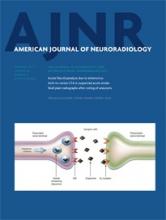Research ArticleBrain
Open Access
Regional Cerebral Arterial Transit Time Hemodynamics Correlate with Vascular Risk Factors and Cognitive Function in Men with Coronary Artery Disease
B.J. MacIntosh, W. Swardfager, A.D. Robertson, E. Tchistiakova, M. Saleem, P.I. Oh, N. Herrmann, B. Stefanovic and K.L. Lanctôt
American Journal of Neuroradiology February 2015, 36 (2) 295-301; DOI: https://doi.org/10.3174/ajnr.A4094
B.J. MacIntosh
aFrom the Canadian Partnership for Stroke Recovery (B.J.M., W.S., A.D.R., E.T., N.H., B.S., K.L.L.)
bPhysical Sciences (B.J.M., B.S.)
dDepartments of Medical Biophysics (B.J.M., E.T., B.S.,)
W. Swardfager
aFrom the Canadian Partnership for Stroke Recovery (B.J.M., W.S., A.D.R., E.T., N.H., B.S., K.L.L.)
cNeuropsychopharmacology Research Group (W.S., M.S., N.H., K.L.L.), Sunnybrook Research Institute, Toronto, Ontario, Canada
ePharmacology/Toxicology (K.L.L., W.S.)
A.D. Robertson
aFrom the Canadian Partnership for Stroke Recovery (B.J.M., W.S., A.D.R., E.T., N.H., B.S., K.L.L.)
E. Tchistiakova
aFrom the Canadian Partnership for Stroke Recovery (B.J.M., W.S., A.D.R., E.T., N.H., B.S., K.L.L.)
dDepartments of Medical Biophysics (B.J.M., E.T., B.S.,)
M. Saleem
cNeuropsychopharmacology Research Group (W.S., M.S., N.H., K.L.L.), Sunnybrook Research Institute, Toronto, Ontario, Canada
P.I. Oh
gToronto Rehabilitation Institute (P.I.O., K.L.L.), Toronto, Ontario, Canada.
N. Herrmann
aFrom the Canadian Partnership for Stroke Recovery (B.J.M., W.S., A.D.R., E.T., N.H., B.S., K.L.L.)
cNeuropsychopharmacology Research Group (W.S., M.S., N.H., K.L.L.), Sunnybrook Research Institute, Toronto, Ontario, Canada
fPsychiatry (N.H., K.L.L.), University of Toronto, Toronto, Ontario, Canada
B. Stefanovic
aFrom the Canadian Partnership for Stroke Recovery (B.J.M., W.S., A.D.R., E.T., N.H., B.S., K.L.L.)
bPhysical Sciences (B.J.M., B.S.)
dDepartments of Medical Biophysics (B.J.M., E.T., B.S.,)
K.L. Lanctôt
aFrom the Canadian Partnership for Stroke Recovery (B.J.M., W.S., A.D.R., E.T., N.H., B.S., K.L.L.)
cNeuropsychopharmacology Research Group (W.S., M.S., N.H., K.L.L.), Sunnybrook Research Institute, Toronto, Ontario, Canada
ePharmacology/Toxicology (K.L.L., W.S.)
fPsychiatry (N.H., K.L.L.), University of Toronto, Toronto, Ontario, Canada
gToronto Rehabilitation Institute (P.I.O., K.L.L.), Toronto, Ontario, Canada.

REFERENCES
- 1.↵
- 2.↵
- Raschpichler M,
- Straatman K,
- Schroeter ML, et al
- 3.↵
- 4.↵
- Xu WL,
- Atti AR,
- Gatz M, et al
- 5.↵
- Gianaros PJ,
- Greer PJ,
- Ryan CM, et al
- 6.↵
- Kuo HK,
- Sorond F,
- Iloputaife I, et al
- 7.↵
- de la Torre JC
- 8.↵
- Sato N,
- Morishita R
- 9.↵
- Joutel A,
- Monet-Lepretre M,
- Gosele C, et al
- 10.↵
- 11.↵
- 12.↵
- 13.↵
- 14.↵
- MacIntosh BJ,
- Lindsay AC,
- Kylintireas I, et al
- 15.↵
- Macintosh BJ,
- Marquardt L,
- Schulz UG, et al
- 16.↵
- Bokkers RP,
- van Laar PJ,
- van de Ven KC, et al
- 17.↵
- 18.↵
- Mak HK,
- Chan Q,
- Zhang Z, et al
- 19.↵
- Yoshiura T,
- Hiwatashi A,
- Yamashita K, et al
- 20.↵
- 21.↵
- Volonghi I,
- Pendlebury ST,
- Welch SJ, et al
- 22.↵
- 23.↵
- Kullmann S,
- Heni M,
- Veit R, et al
- 24.↵
- 25.↵
- 26.↵
- 27.↵
- 28.↵
- Alsop DC,
- Detre JA,
- Golay X, et al
- 29.↵
- Buxton RB,
- Frank LR,
- Wong EC, et al
- 30.↵
- Hachinski V,
- Iadecola C,
- Petersen RC, et al
- 31.↵
- Nichols TE,
- Holmes AP
- 32.↵
- Smith SM,
- Nichols TE
- 33.↵
- Greicius MD,
- Srivastava G,
- Reiss AL, et al
- 34.↵
- Celone KA,
- Calhoun VD,
- Dickerson BC, et al
- 35.↵
- Webb AJ,
- Simoni M,
- Mazzucco S, et al
- 36.↵
- Hirata K,
- Yaginuma T,
- O'Rourke MF, et al
- 37.↵
- Damoiseaux JS,
- Beckmann CF,
- Arigita EJ, et al
- 38.↵
In this issue
American Journal of Neuroradiology
Vol. 36, Issue 2
1 Feb 2015
Advertisement
B.J. MacIntosh, W. Swardfager, A.D. Robertson, E. Tchistiakova, M. Saleem, P.I. Oh, N. Herrmann, B. Stefanovic, K.L. Lanctôt
Regional Cerebral Arterial Transit Time Hemodynamics Correlate with Vascular Risk Factors and Cognitive Function in Men with Coronary Artery Disease
American Journal of Neuroradiology Feb 2015, 36 (2) 295-301; DOI: 10.3174/ajnr.A4094
0 Responses
Regional Cerebral Arterial Transit Time Hemodynamics Correlate with Vascular Risk Factors and Cognitive Function in Men with Coronary Artery Disease
B.J. MacIntosh, W. Swardfager, A.D. Robertson, E. Tchistiakova, M. Saleem, P.I. Oh, N. Herrmann, B. Stefanovic, K.L. Lanctôt
American Journal of Neuroradiology Feb 2015, 36 (2) 295-301; DOI: 10.3174/ajnr.A4094
Jump to section
Related Articles
Cited By...
This article has not yet been cited by articles in journals that are participating in Crossref Cited-by Linking.
More in this TOC Section
Similar Articles
Advertisement











